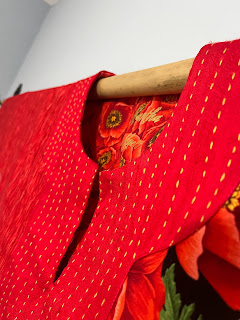A dear elderly - that is, older than me - friend keeps cleaning out her stash and giving me quilt cottons. Though my quilting activity is low, my traditional quilting activity is non-existent. Recently she gifted me a stack of red Christmas prints. I said Thank you.
Now I do love red. My dear sainted mother used to say that red is her neutral. When it's cold enough, I wear a long red wool coat bought at Talbot's decades ago in her honor. Red has a special place in my heart.
Emilie Flöge is the clothing designer behind the beautiful garments worn by those Viennese women in Klimt's colorful paintings. She has a storied past that piqued my interest. She was a companion of Klimt's, a hippie in her own time, a free spirit. Her designs are works of art, detailed, exquisite.
I chose a favorite pattern from Folkwear: 104 Egyptian shirt. I have used this pattern at least 4 previous times. There is something appealing to me in its rectangular lines. My most worn version is in an interesting white linen weave. Extended full length, it is called a galabia.
By combining so many red prints, my hope was to get away from the Christmas theme. Some of the pieces were 1/2 yard; a few were a full yard. I cut them into 8" x 18" chunks. I created fabric, sort of, by sewing them together along the short ends, making one very long 8" wide strip of fabric. There was no plan to the order in which they were sewn together, except to avoid sewing identical fabrics together.
I chose the 8" width based on the size of the front and back pieces in the Egyptian shirt pattern. Along the way, I wondered if I needed to break up all that red print, perhaps with something like a black and white print piping. That did not work out - it looked more like Little House on the Prairie than it did Turn of the Century Vienna.
For the facing, I used a remnant of red silk dupioni, sashiko-stitched in vertical lines. I backed it with cotton batiste. Once I had completed the garment, I thought to check to see how the shoulders lined up. Of course, I needed to do a little after-the-fact sashiko correction.
I added an interior back facing of the red print quilt cotton so that the back side of the cotton print does not show when it is hanging. I am pleased with how it looks hanging on the wall of my sewing room.
The Egyptian shirt pattern resembles the lines of the Fit for Art Tabala Rasa pattern, another I've used multiple times. It also resembles the Sterling pattern from the Sewing Workshop. Good design is present in all cases. This traditional design includes clever and easy pockets in the side panels.
My long-term plan for this piece is to use it as a summer weight robe. While at Shakerag this summer, my sweet roomie demonstrated the need for such when she accidentally locked herself out of our room following a shower in the communcal bathroom.
This piece already has a few stories sewn into it.















Love seeing this. Just lovely, as I would have truly expected !
ReplyDeleteSuper! And the art history intro, lead me to put the books mentioned on my reading list! Thank you for the inspiration! Sewing and reading.
ReplyDeleteWhat a lovely work of art this dress/robe is! You can really see the link to the inspiration and you're right that the use of all reds really tones down the Christmas-y-ness of the prints. Thank you for introducing me to Flöge - I hadn't heard of her before.
ReplyDeleteYour galabiya style dress is so beautiful. The exuberant red prints are perfect as they echo the intricate embroidery on the vintage Palestinian dresses I remember lusting after in the late 1960's.
ReplyDelete